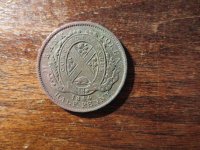X-Terra70_TreasureHunter
Hero Member
- Oct 19, 2007
- 656
- 13
- Detector(s) used
- X-Terra70, X-Terra 50, Ace250, Ace150, GTI 1500,GTA 1000 Ultra, Tejon, Vaquero
BY John Whitecloud
Essentially, metals (and some non-metals) can be placed in one of three categories:
ferromagnetic, paramagnetic, and diamagnetic.
Ferromagnetic means that the metal will become magnetized by a magnetic field, for at least some period after the magnetizing force is taken away. Iron is surely the most common of these metals (hence the term "ferro" (iron) magnetic). Two others ferromagnetic metals that a detectorist may encounter are nickel and cobalt. As I'm sure you know, lots of coins contain nickel, and it's ferromagnetic. Cobalt is rare, but can still be encountered.
Paramagnetic means that the material will accept and become magnetic, but will immediately cease to be magnetized once the magnetic field is taken away. Aluminum is a common paramagnetic metal.
Lastly, Diamagnetic metals are those that actually oppose being penetrated by a magnetic field. Gold, silver and copper are diamagnetic metals. Essentially, these materials oppose the magnetic field and produce "eddy currents" on their surface in order to dissipate the magnetic energy.
Okay, I know that you already know this, but, metal detectors, have a magnetic conductivity scale. On this type of metal detector, the scale starts on the left with Ferromagnetic metals (iron, foil,...), in the middle of the scale is paramagnetic metal (aluminum...), and on the right is diamagnetic metal (gold, silver, copper).
So, iron, aluminum, gold, copper and silver, etc., give us the tones we hear as the coil passes over a target.
Dave
Essentially, metals (and some non-metals) can be placed in one of three categories:
ferromagnetic, paramagnetic, and diamagnetic.
Ferromagnetic means that the metal will become magnetized by a magnetic field, for at least some period after the magnetizing force is taken away. Iron is surely the most common of these metals (hence the term "ferro" (iron) magnetic). Two others ferromagnetic metals that a detectorist may encounter are nickel and cobalt. As I'm sure you know, lots of coins contain nickel, and it's ferromagnetic. Cobalt is rare, but can still be encountered.
Paramagnetic means that the material will accept and become magnetic, but will immediately cease to be magnetized once the magnetic field is taken away. Aluminum is a common paramagnetic metal.
Lastly, Diamagnetic metals are those that actually oppose being penetrated by a magnetic field. Gold, silver and copper are diamagnetic metals. Essentially, these materials oppose the magnetic field and produce "eddy currents" on their surface in order to dissipate the magnetic energy.
Okay, I know that you already know this, but, metal detectors, have a magnetic conductivity scale. On this type of metal detector, the scale starts on the left with Ferromagnetic metals (iron, foil,...), in the middle of the scale is paramagnetic metal (aluminum...), and on the right is diamagnetic metal (gold, silver, copper).
So, iron, aluminum, gold, copper and silver, etc., give us the tones we hear as the coil passes over a target.
Dave




